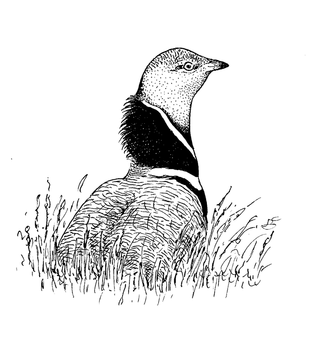
The European atlas (1997) suggested that there were over 200,000 individual Little Bustards in Spain (with a further 13,000 – 18,000 in Portugal). The Spanish atlas (2004) suggests, if my poor Spanish is correct, that there were between 50,000 – 100,000 breeding males. However, recent figures suggest that this has declined to 20,000-25,000 breeding males. Using the information from the atlas and elsewhere, I’ve drawn a sketch map of their distribution in Andalucia where the most recent survey now gives the population of 5,259 breeding males. Although declining, those populations in Andalucia that are outliers of a larger population elsewhere (i.e. eastern Huelva, and north-western Cordoba) are probably under less immediate threat as are the larger blocks of population in Seville and Cordoba/Jaen. However, the population elsewhere in Andalucia is clearly fragmented with local extinction a real possibility in some of the smaller more isolated ‘pockets.’ This seems to have happened in Huelva where the species hasn’t bred in recent years in the Coto Donana (although up to twenty odd non-breeding birds apparently still occur).
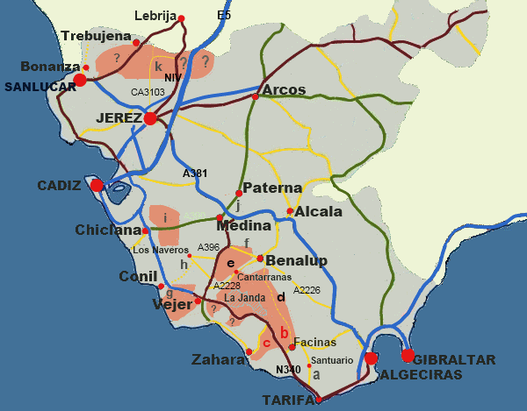
So, what is the situation in Cadiz province? Unfortunately, my atlas of the breeding birds of Cadiz province is out in Spain, but from the nationwide atlas, my recollection of habitats in the area and other sources, I’ve drawn up a map (Map 2 below) to give a rough idea. All the information is in the public domain (albeit some fairly obscure sources), but I think it’s worth collating it to try to give some sort of overview. I’m also acutely aware of the limits of my knowledge, but hope my observations will provoke some interest. It need hardly be said, but with a declining and vulnerable species birders should behave with some sensitivity if they find the species in the area.
According to several sources, the road inland north of Tarifa to the Santuario de la Luz (a), used to hold Little Bustard, but I’ve not heard from anyone who’s seen them recently. The vast wind farms along the N340 probably account form their apparent disappearance there (b & c). However, there are apparently still present along the old drovers’ road between Facinas and Benalup west of La Janda – see (d). A few years ago there was a flock in winter at the start of this track near Benalup, but a couple of houses have recently been built nearby so prospects no longer look so good. The southern part of is road is in such shocking condition these days that I no longer venture along it, but it does seem one of the better bets. Whether they occur south of the N340 here I am unsure although much of the habitat looks unsuitable. Certainly, with much of La Janda being given over to rice cultivation large areas are unsuitable for bustards. I’ve also looked, albeit without success, just south of Benalup and along the road south of the Embalse de Barbate where the habitat looks as good as anywhere. I’ve had better luck in the fields between the A396 and Cantarranas (e) and a local birder tells me they’re present nearby (f). Further west the rolling fields near Vejer (g) look the part and they were here for the atlas survey, but whether they remain I’m uncertain. Another informant has also seen them near Los Naveros (h) where a large wind farm is under construction. Birds have also been seen off the A381 over towards Paterna (j) which isn’t a surprise as much good habitat still remains, but again several large wind farms have appeared here. Whether they are still found near Chiclana (i) I don’t know although the habitat looks inviting enough to me. Once, though, this area has seen the construction of many wind farms. The Spanish atlas suggests birds to the north of Jerez. To me much of the habitat north of the Sanlucar-Trebujena road looks unsuitable, but at least some of the fields along the CA3103 still look as if the might harbour the species. I’ve heard it rumoured that they no longer breed in this area although, presumably, non-breeding birds might be found. However, this is an area I’ve hardly explored. This is something I mean to rectify as I need to discover how the access the Marismas de Casablanca on the Seville/Cadiz border (where I’ve seen Pin-tailed Sandgrouse – from the train!
So, if you come to Cadiz province in the hope of seeing Little Bustard you will need a lot of luck – so much so that I suggest you’d be much better off exploring the steppe around Carmona and Osuna (Seville) which also has Great Bustard. If you’re still determined to see them in the province, my best advice is to contact Stephen Daly ( www.andalucianguides.com) who’s in the field most days and knows the region better than anyone.
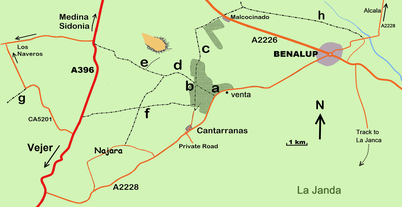
As this is also a favourite site for Red-necked Nightjar, I often to come in the late afternoon and stay into the evening although early morning is probably better for bustards. Approaching along the A2228 from Benalup I turn north up a rutted track (a) through old olive groves just after a small venta (not recommended – it’s the only place in Spain that refused to serve us coffee!). Take care as it’s on a long left hand bend. If you miss it then continue into Cantarranas, turn right near the church and head north. Although there are Red-necked Nightjars throughout the area, the birds at the crossroads (b) never disappoint. It’s also a great spot for Hoopoes. You can continue along this track (c) to reach another interesting area (h) which I’ll come back to later. Continuing up to the top of the slope (d) you get to enjoy a great panorama (plus Montagu’s Harrier, Quail, Woodchat Shrike, Calandra Larks, Red-rumped Swallows, etc), but the real star of the show – Black-winged Kite - usually only appears with the dusk. By which time, you’ll be wanting to double back down to (b) for nightjar. A rough track (e), better walked, runs up towards a steep hill to give an even more impressive view; I’ve not fully explored this route but it should be interesting. Just before this track a farm track heads south towards (f) which can also be reached from Cantarranas, Najara and the A396. All of these tracks offer good views over suitable bustard (and Stone Curlew) habitat so regularly stop and scan with bins and ‘scope.
With one exception, I’ve not fully explored further north along the A396 or to the west of this road. The exception is a terrific track (g) just south of Los Naveros. This runs through some superb habitat to reach the new coastal motorway near Conil. This is another good area for Black-winged Kite and all the other birds noted above. Little Bustard have also been seen here. Two warnings – heavy lorries often use this road so take care and be wary of the cattle as fighting bulls are raised along this track. One final area that deserves mention is the track (h) the runs from the A2228 to Malcocinado. Before you reach this track (if coming from Alcala) check the eucalyptus trees by the bridge as they often have Spanish Sparrow. You swing right then left after the bridge to reach Benalup, but as you turn right continue straight on along a good track. With so many places to explore, I never got round to exploring this track until last year. However, a local birdwatcher told me that this was a good area for Little Bustard. I’ve not yet seen them here, but the habitat does look suitable and worth a look. (Note – other tracks lead off this one that I’ve not yet explored at all).
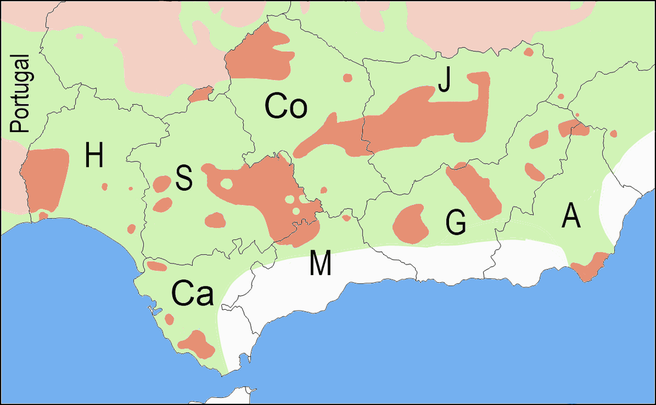
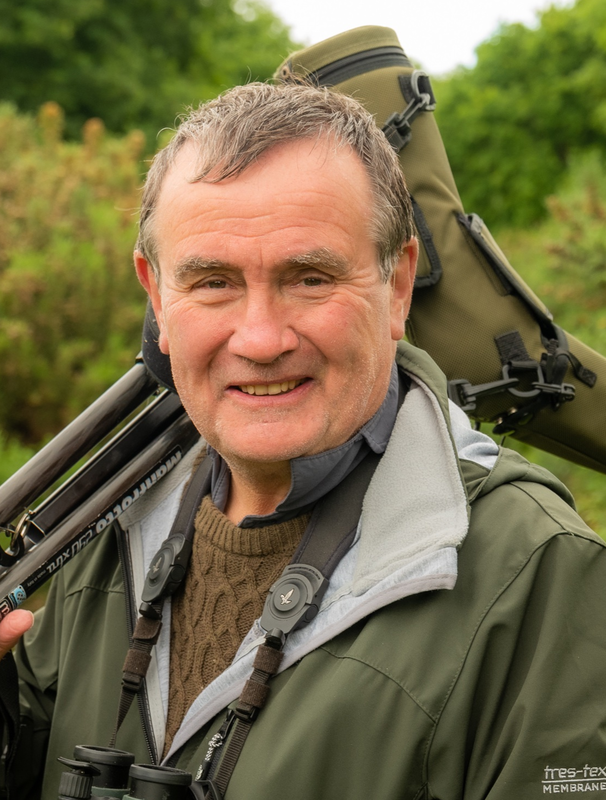
 RSS Feed
RSS Feed
